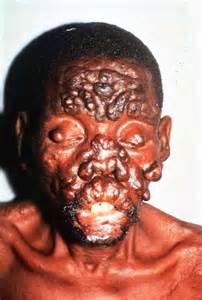Leprosy

Description:
Leprosy is an ansient disese and is a leading cause of permanent physical disability among the communicable diseases. It is a chronic mildly communicable disease that mainly affects the skin, the peripheral nerves, the eyes and mucosa of the upper respiratory tract.
Signs and Symptoms
A. Early Signs and symptoms
Infectious Agent:
Modes of Transmission:
Incubation Period:
The incubation period is difficult to determine. It probably ranges from nine months to 20 years with an average of four years for tuberculoid leprosy and eight years for lepromatous leprosy.
Prevention:
Leprosy is an ansient disese and is a leading cause of permanent physical disability among the communicable diseases. It is a chronic mildly communicable disease that mainly affects the skin, the peripheral nerves, the eyes and mucosa of the upper respiratory tract.
Signs and Symptoms
A. Early Signs and symptoms
- change in skin color
- Loss of sensation on the skin lession
- Decrease/loss of sweating and hair growth over the lession
- Thickened and or painful nerves
- Muscle weakness or paralysis of extremeties
- Pain and redness of the eyes.
- Nasal obstruction or bleeding
- Ulcers that do not heal
- Loss of eyebrows
- Inability to close eyelids
- Clawing of fingers and toes
- Contractures
- Sinking of nosebridge
- Enlargement of the breast in males
Infectious Agent:
- Mycobacteriom leprae an acid fast, rod-shaped bacillus which can be detected by Slit Skin Smear (SSS)
Modes of Transmission:
- Airborne
- Prolonged skin-to-skin contact
Incubation Period:
The incubation period is difficult to determine. It probably ranges from nine months to 20 years with an average of four years for tuberculoid leprosy and eight years for lepromatous leprosy.
Prevention:
- Avoidance of prolonged skin-to-skin contact especially with a lepromatous case
- Children should avoid close contact with active, untreated leprosy case
- BCG vaccination
- Good Personal Hygiene
- Adequate nutrition
- Health education
